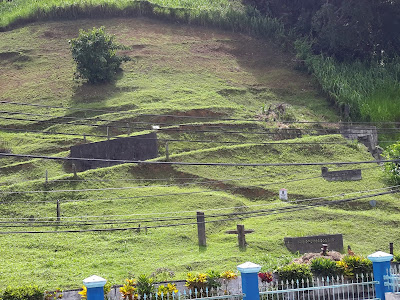ST HELENA TO FERNANDO DE NORONHA,
BRAZIL
FEBRUARY 19 – MARCH 5, 2017
We departed
the St Helena mooring field at 1130 hrs (UTC-2) on February 19th,
2017. This leg of the voyage provided
the best downwind sailing we have ever experienced: day after day of constant
SE’ly Trade winds blowing 10-20 kts; very few squalls and moderate seas. It just doesn’t get any better. “Solstice” is a cutter rigged yacht. This means that we have a forestay shroud
that will accommodate a poled out staysail.
In Phuket, Thailand I had two stainless steel eyes riveted on the port
and stbd. side of the mast so that a whisker pole could be clipped on and led
outboard at a 90 degree angle.
Additionally, we have a carbon fiber pole on a track that allows the
genoa to be poled out on the port or stbd. side. This translates into being able to sail
downwind with a poled out genoa and a poled out staysail. In a 15 kt wind, the yacht can make 6.5-7.0
kts effortlessly and be very comfortable.
There will be some rolling as each sail pulls and eases but the motion
is comfortable.
The great
South Atlantic Ocean is a vast oceanic wilderness with few places to stop in
case of an emergency. Several yachts had
had problems with their rudders and had to abandon ship and be rescued by
merchant vessels. To add a safety
feature to the long passage from Cape Town to St Helena (1700 nm), St Helena to
Fernando de Noronha (1736 nm), Fernando de Noronha to Tobago (1900 nm), we
agreed to sail with another yacht: a 36’ Malo named “Norsa”. What this meant was that because “Solstice”
is 40’ and “Norsa” is 36’, the bigger boat would have to reduce sail area so
that the other could keep up. Because
this was a downwind sailing voyage, we weren’t able to use the twin jibs all
the time unless “Norsa” was flying a spinnaker type of sail known as the “Parasailor”
which gave them extra sail area and speed.
They were reluctant to do this during the night because of squalls and
increased wind speed. It was a
compromise for both vessels. We sailed
together about 1-1/2 nm apart and communicated via VHF radio at scheduled
times. The thought behind this was that,
if an emergency occurred, one vessel would be able to standby and assist or tow
the other if needed.
The
following mileage figures indicate sail reduction by “Solstice” to accommodate
“Norsa’s” speed. If sailing alone, we
would have averaged an additional 24 nm per day:
Feb 20th 119 nm
Avg. Speed = 5.0 kts
Noon-to-Noon DTG =1617
Feb 21st 128 nm
Avg. Speed = 5.3 kts Noon to-
Noon 1489
Feb 22nd 133 nm
Avg. Speed = 5.5 kts Noon-to-
Noon 1356
Feb 23rd 124 nm
Avg. Speed = 5.2 kts
Noon-to-Noon 1232
Feb 24th 129 nm
Avg. Speed = 5.4 kts Noon
–to-Noon 1107
Feb 25th 116 nm
Avg. Speed = 4.8 kts Noon-to-Noon 991
Feb 26th 104 nm
Avg. Speed = 4.3 kts Noon-to-Noon 887
Feb 27th 119 nm
Avg. Speed = 5.0 kts Noon-to-Noon 768
Feb 28th 123 nm
Avg. Speed = 5.1 kts Noon-to-Noon 645
March 1st 123 nm
Avg. Speed = 5.1 kts Noon-to-Noon 522
March 2nd 127 nm
Avg. Speed = 5.3 kts
Noon-to-Noon 395
March 3rd 149 nm
Avg. Speed = 6.2 kts
Noon-to-Noon
246
March 4th 133 nm
Avg. Speed = 5.5 kts
Noon-to-Noon
113
March 5th 113 nm
Avg. Speed = 5.0 kts in 22.5 hrs 0
Total
Distance Made Good = 1740 nm in 335 hrs @ 5.2 kts avg.
During this
passage, the SE Trade Winds were fully established and never varied much with
an average of 15 kts and a ½ -1.0 kts favorable current. Some adverse current was experienced at
times.
Dropped
anchor in Fernando de Noronha at 1030 hrs (UTC-2) on March 5th, 2017
on a sandy bottom in 45’ water depth.
The anchorage is rolly but tolerable.




























